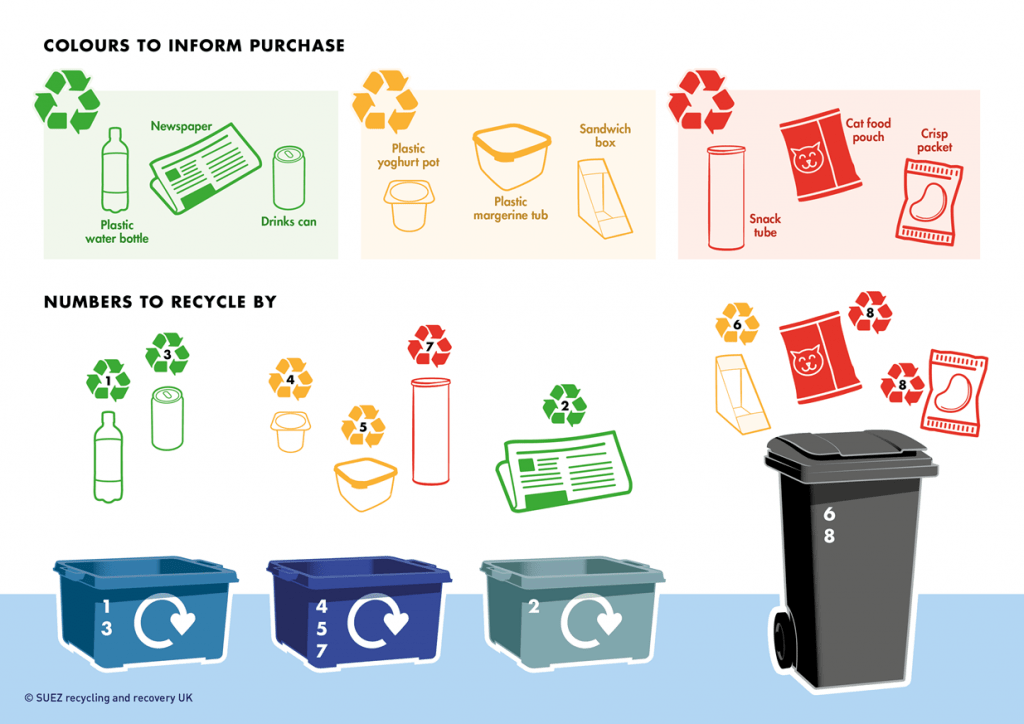The mythical Green Dot of recycling
12th September 2019

Posted by Sarah Ottaway
Sustainability and Social Value Lead at SUEZ recycling and recovery UK
Our industry relies on us as individuals making the right decision up to 36 times a day on which bin we should put the item we no longer want. Whether it’s at home, or work, or when we’re out and about, our decision sends that item to its next destination. The wrong decision can have far reaching consequences, as many of us are all too aware, when comes to contamination in the bin and the problems it creates.
So how can we combat this?
Quality recycling is an essential component of a circular economy, but in order to capture it consistently we need individual decision making to be informed, yet quick and easy for everyone to make the right decision, every time. This is something that is not happening currently, especially when it comes to plastic packaging.
When looking at any item of packaging, you are bombarded with information – from nutritional details, to its place of origin and even heating or storage instructions – meaning any information related to recycling competes for our attention, and is often not placed in a prominent position. And, to complicate matters, when you do find any information to help you decide what to do with your empty piece of packaging, you come face-to-face with a range of unexplained symbols, the most common amongst them is the ‘Green Dot’ – Mobius loop and On Pack Recycling Label (OPRL).
The Green Dot
A recent study by Recoup highlighted that all respondents were misled by the Green Dot symbol, and noted that the Mobius loop symbol represents the ability of the household recycling system to accept these items. Neither of these statements are true.
There has been concern over the use of the Green Dot on UK packaging for some time, particularly as it doesn’t represent investment in our own packaging recovery notes (PRN) system. This was recently showcased by BBC Watchdog, who visited one of SUEZ’s material recycling facilities (MRFs) so they could see first-hand the issues the industry faces on a daily basis when the public put the wrong items in their recycling bins. It was clear that Cel Spellman (BBC One, BBC Sounds DJ and environmental campaigner) and the crew were genuinely frustrated with the use of the Green Dot symbol and spent time on the streets of Manchester collecting the public’s reaction when they realised that the symbol had nothing to do with our recycling system. It wasn’t a positive response, and clearly this is not helping us to make those quick, easy and informed decisions we need and want to make.
In contrast, the On Pack Recycling Label (OPRL) system has made huge strides in trying to simplify a complex world. OPRL covers 95% of the grocery sector with its 400 members, a significant presence on much of the packaging we use every day.
Recoup found that respondents found it useful, but most notable when recycling information was clear and prominent on the packaging. However this system suffers from our inconsistent recycling system which results in the dreaded “check locally” option frequently appearing, which some respondents still admitted that they would not look up Local Authority instructions, increasing the probability that individuals will choose to follow one of the other symbols, or make a somewhat “educated” guess.
How can we recycle more?
In order for us to overcome these issues and communicate clearly, we need a consistent set of materials being presented by households and businesses.
Recent consultation from DEFRA states just this – consistent collections, a crucial piece of the puzzle which will be welcomed by many.
Every local authority will collect the same materials in every location, creating ‘municipal type waste’. This will give waste manager, producers and manufacturers the opportunity to transform the current system so communication can become clear, no matter what bin, bag or box we use for recycling, or whether we are at home or work.
Recycling by numbers
SUEZ has advocated the use of a recycle by numbers system – we, consumers, simply match the number on our packaging with the number on our bins wherever we are in the country. This would encourage quick, easy and informed decision making by individuals regardless of the system in front of us, all we would need to know is which number goes in which container. In addition to this, a traffic light system will symbolise the recyclability of that product in order to make informed decisions when purchasing our packaged items in the first place. This is something I hope will be considered in OPRL’s review of its system, which is currently in progress.
With the mix of DEFRA’s consultations on consistent collections and extended producer responsibility (EPR), alongside OPRL’s review, there is plenty to feel enthused about for the future of packaging and our ability to deliver a truly circular economy.
However, if we continue to see other misleading labels, such as the Green Dot, alongside our future OPRL system, will we really overcome the confusion plaguing our quality recycling?
Tweet
